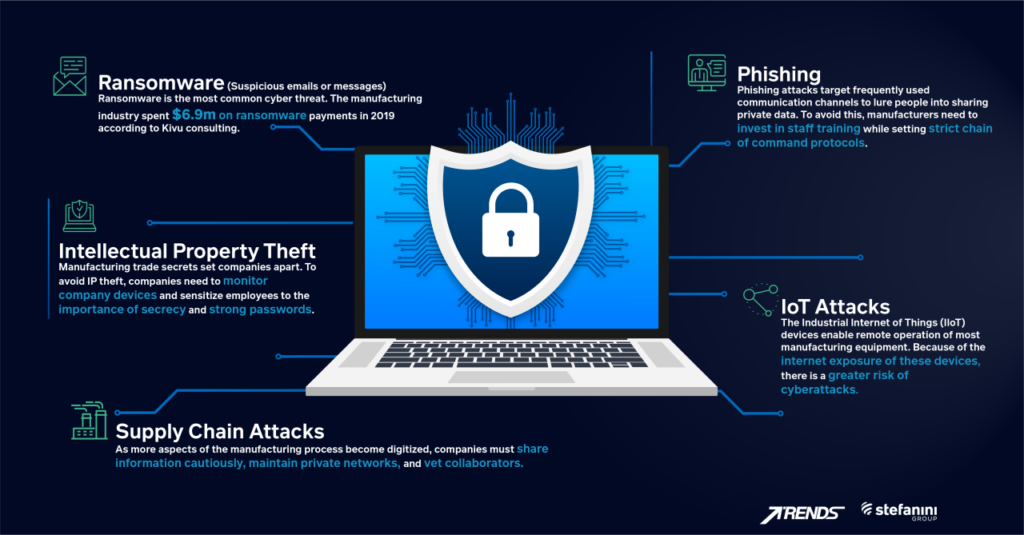Technological advancements have led to massive growth in the manufacturing industry. Organizations are no longer confined to the old, offline trends but are making significant shifts to robust online activities. Because of this, it is easier for their security is also compromised. According to Varonis, manufacturing is now ranked among the most at-risk industries. In 2019 alone, Varonis reported a 21% exposure of sensitive files in the manufacturing industry. In the same report, 23% of other folders were also exposed.
For this reason, manufacturers need to understand the kind of cybersecurity threats they face. They also need to be aware of how to tackle the threats and mitigate unexpected risks.
5 Common Cybersecurity Threats and How They Affect Manufacturing

1. Ransomware
Ransomware is the most common of all types of cyber threats. It affects most businesses, with manufacturers being most at risk. The reason ransomware is prevalent is that it is easy to execute. A simple email or an official document can easily be used to launch the attack.
Mostly, this happens when employees open the infected attachments. Clicking the email attachment or any other malicious link quickly exposes the system to cyber criminals. And once the ransomware creeps into your systems, all your sensitive data will be decrypted. Also, the possibility of this malware spreading to the entire network is pretty high.
In the long run, organizations end up losing revenue due to downtime. Not to mention the recovery expenses that may never be reimbursed. Additionally, customer data is compromised. And with this comes the risk of irreparable reputational damage. Ransomware is unforgiving, and most businesses never recover from the attacks. To shield your manufacturing business from ransomware attacks, keep your employees informed and train your subordinates on how to identify malicious emails and attachments.
Additionally, take the time to secure your system. Ensure limited access to files that contain sensitive data. Such files should also be secured in different locations. This is to ensure a single click on a link does not guarantee access to all files.
To further strengthen your security, it would be best to have an expert in online security solutions. Consider having a vendor that provides a 24/7 network monitoring program to your industrial control systems (ICS). With reliable ICS vendors, the creation, implementation, assessment, and monitoring of your cybersecurity threats is manageable. You also get specialized engagement at each of the following critical manufacturing sections:
- Emerging technologies
- Foundational technologies
- OEMs
- Access Control
- Asset Management
- Network Infrastructure
- Enterprise tools
- Services
- Security
- Reporting and standards
Want to learn more about how to secure your system in a transformed business? Click here!
2. Intellectual Property Theft
Manufacturing is built along with the innovations and ideas of the owners. It consists of trade secrets and products that set apart one company from another. These ideas are unique, and if any of them gets into the wrong hands, it can compromise an organization’s operations.
This is just one of the many reasons that intellectual property theft is frightening a concern for most manufacturing firms, mainly because they depend on intellectual property (IP) to be competitive. IP also determines how long they remain relevant in the industry.
To shield themselves from IP theft, manufacturers need to understand their weakest point – human error. An employee sending sensitive company data to the wrong people can open an organization to IP theft. Also, a team member losing a device containing trade secrets puts your company at risk.
Therefore, to avoid IP theft, companies need to sensitize employees about the importance of secrecy and strong passwords. They also need to monitor company devices to ensure no information is leaked. Additionally, manufacturers should have official non-disclosure contracts that bind employees to secrecy.
3. Supply Chain Attacks
There is increasing digitization across all aspects of the manufacturing process. From extraction to supply chain warehousing, manufacturers are now moving most of their operations online.
Because of the strong internet presence, manufacturers need to be aware of the threat of supply chain attacks. The information they share with industry partners or providers could be a weak link in their security.
Manufacturers need to be careful with the financial, intellectual, and operational information they give to collaborators. This is to avoid instances of the data being used to access private networks and steal information.
Manufacturers also need to know who their collaborators are. A background check on their dealings could help determine their trustworthiness. As manufacturing industries aim for massive expansion, they also need to be careful with their choice of third parties.
Learn more about how our Smart Manufacturing solutions can evolve you security. Click here!
4. Phishing
Phishing is probably one of the most common attacks a business could face. It targets frequently used communication channels to lure people into sharing private data. In the manufacturing industry, emails are the most commonly used tools for these attacks. A criminal will send attention-grabbing emails to lead unsuspecting people to share company information.
The most common tactic they use is a sense of urgency. They’ll ask an employee to share logins or passwords and only offer a short time to reveal the information. It can be easy for an employee fall for this, especially if the email used names coworkers or superiors to reinforce the email’s urgency.
If an employee follows an attached link, Phishing attacks can then give the cybercriminals’ access to a companys’ network that then leads to more significant attacks.
To avoid this, manufacturers need to invest in staff training while also being strict on the chain of command or protocols for company security. This avoids instances of employees sharing information without passing it through departmental managers. A security strategy that proves quite effective is for the employee to contact those mentioned in the phishing email via company communication platforms and confirm the priority of the original message.
5. IoT Attacks
The Internet of Things (IoT) provides the ability to connect physical and virtual environments. The devices enable remote operation of most manufacturing equipment. Because of the internet exposure of these devices, there is also a greater risk of cyberattacks.
For example, using IoT-connected manufacturing equipment poses risks of operational disruption. If a criminal gains access to the device, they can interfere with production flow. Also, a hacker’s access to an IoT device can lead to a compromise of your other systems. Access to one system can give them a pass to the entire manufacturing process.
Because of this, manufacturers need to be careful with the connectivity of IoT devices. They need to limit how much these devices connect to other company systems. Additionally, they must ensure that the IoT providers have top-notch security systems. This is to make sure that they are aware of new vulnerabilities and quick to mitigate the risks.
Ready to securely unlock the benefits of Industry 4.0 and IoT? Click here to learn more!
Proven Practices to Mitigate Security Risks
Security issues in the manufacturing industry can be prevented. This can be done by defining the role of the Informational Technology (IT) and Operational Technology (OT) employees. There should also be cultural exchanges and pilot programs to foster teamwork and responsibility among members. Also, encourage the sharing of viewpoints, needs, and challenges with one another.
Additionally, follow these routines to secure your manufacturing business.
- Keep a record of all your devices to determine the most critical assets in your possession.
- Separate your networks to cut down on risks during an attack.
- Distribute these networks to diverse team members to improve the efficiency of network monitoring.
- Have a vulnerability management team that monitors progress, addresses attacks, and mitigates risks.
Manufacturing companies need to be aware of the evolution of cybersecurity and understand the threats. Doing this will help them protect their systems, IP, and data. Ensuring that your manufacturing company exercises proper safety guards will protect you from massive losses.
Want to learn how the right Managed Security Services can protect your business? Click here
Author’s bio: Dan is the editor in Industrial Defender. He has got hands-on experience in writing on cybersecurity. Our solution helps companies apply the 5 foundational security controls in their OT environments to reduce cyber risk by 85%.



















